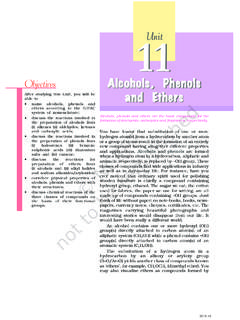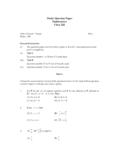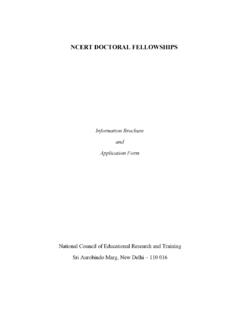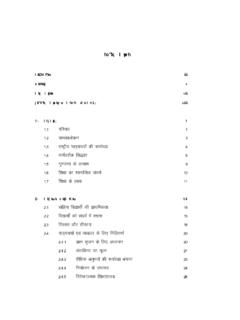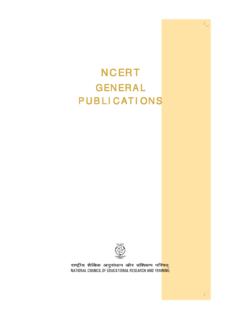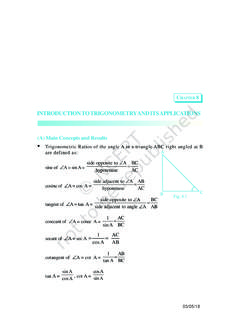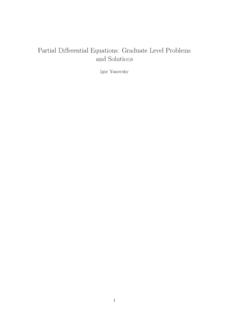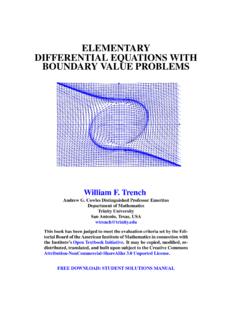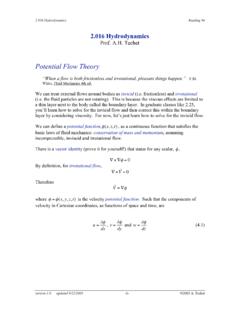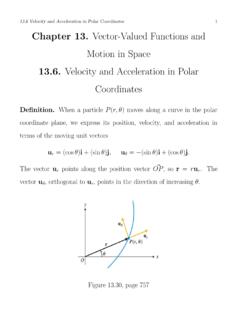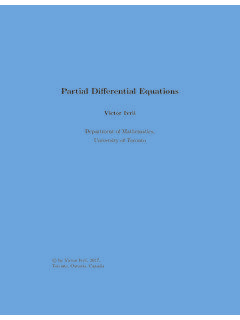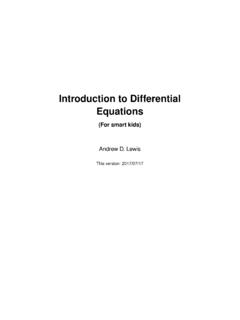Transcription of COMPLEX NUMBERS AND QUADRATIC EQUA TIONS - NCERT
1 Chapter 5. COMPLEX NUMBERS AND. QUADRATIC equations . Overview We know that the square of a real number is always non-negative (4)2 = 16 and ( 4)2 = 16. Therefore, square root of 16 is 4. What about the square root of a negative number? It is clear that a negative number can not have a real square root. So we need to extend the system of real NUMBERS to a system in which we can find out the square roots of negative NUMBERS . Euler (1707 - 1783) was the first mathematician to introduce the symbol i (iota) for positive square root of 1 , i = 1 . Imaginary NUMBERS Square root of a negative number is called an imaginary number., for example, 9 = 1 9 = i3, 7 = 1 7 =i 7. Integral powers of i i= 1 , i 2 = 1, i 3 = i 2 i = i , i 4 = (i 2)2 = ( 1)2 = 1. To compute in for n > 4, we divide n by 4 and write it in the form n = 4m + r, where m is quotient and r is remainder (0 r 4).
2 Hence in = i4m+r = (i4)m . (i)r = (1)m (i)r = ir For example, (i)39 = i 4 9 + 3 = (i4)9 . (i)3 = i3 = i and (i) 435 = i (4 108 + 3) = (i) (4 108) . (i) 3. 1 1 i = 4 108 . 3 = 4 = i (i ) (i) (i ). (i) If a and b are positive real NUMBERS , then a b = 1 a 1 b = i a i b = ab (ii) a. b = ab if a and b are positive or at least one of them is negative or zero. However, a b ab if a and b, both are negative. 18/04/18. 74 EXEMPLAR PROBLEMS MATHEMATICS. COMPLEX NUMBERS (a) A number which can be written in the form a + ib, where a, b are real NUMBERS and i = 1 is called a COMPLEX number. (b) If z = a + ib is the COMPLEX number, then a and b are called real and imaginary parts, respectively, of the COMPLEX number and written as Re (z) = a, Im (z) = b. (c) Order relations greater than and less than are not defined for COMPLEX NUMBERS .
3 (d) If the imaginary part of a COMPLEX number is zero, then the COMPLEX number is known as purely real number and if real part is zero, then it is called purely imaginary number, for example, 2 is a purely real number because its imaginary part is zero and 3i is a purely imaginary number because its real part is zero. Algebra of COMPLEX NUMBERS (a) Two COMPLEX NUMBERS z1 = a + ib and z2 = c + id are said to be equal if a = c and b = d. (b) Let z1 = a + ib and z2 = c + id be two COMPLEX NUMBERS then z1 + z2 = (a + c) + i (b + d). Addition of COMPLEX NUMBERS satisfies the following properties 1. As the sum of two COMPLEX NUMBERS is again a COMPLEX number, the set of COMPLEX NUMBERS is closed with respect to addition. 2. Addition of COMPLEX NUMBERS is commutative, , z1 + z2 = z2 + z1.
4 3. Addition of COMPLEX NUMBERS is associative, , (z1 + z2) + z3 = z1 + (z2 + z3). 4. For any COMPLEX number z = x + i y, there exist 0, , (0 + 0i) COMPLEX number such that z + 0 = 0 + z = z, known as identity element for addition. 5. For any COMPLEX number z = x + iy, there always exists a number z = a ib such that z + ( z) = ( z) + z = 0 and is known as the additive inverse of z. Multiplication of COMPLEX NUMBERS Let z1 = a + ib and z2 = c + id, be two COMPLEX NUMBERS . Then z1 . z2 = (a + ib) (c + id) = (ac bd) + i (ad + bc). 1. As the product of two COMPLEX NUMBERS is a COMPLEX number, the set of COMPLEX NUMBERS is closed with respect to multiplication. 2. Multiplication of COMPLEX NUMBERS is commutative, , = 3. Multiplication of COMPLEX NUMBERS is associative, , ( ).
5 Z3 = z1 . ( ). 18/04/18. COMPLEX NUMBERS AND QUADRATIC equations 75. 4. For any COMPLEX number z = x + iy, there exists a COMPLEX number 1, , (1 + 0i). such that z . 1 = 1 . z = z, known as identity element for multiplication. 1. 5. For any non zero COMPLEX number z = x + i y, there exists a COMPLEX number z 1 1 1 a ib such that z = z = 1 , , multiplicative inverse of a + ib = = . z z a + ib a 2 + b2. 6. For any three COMPLEX NUMBERS z1, z2 and z3 , z1 . (z2 + z3) = z1 . z2 + z1 . z3. and (z1 + z2) . z3 = z1 . z3 + z2 . z3. , for COMPLEX NUMBERS multiplication is distributive over addition. Let z1 = a + ib and z2( 0) = c + id. Then z1 a + ib (ac + bd ) (bc ad ). z1 z2 == = 2 2. +i 2. z2 c + id c +d c +d2. Conjugate of a COMPLEX number Let z = a + ib be a COMPLEX number.
6 Then a COMPLEX number obtained by changing the sign of imaginary part of the COMPLEX number is called the conjugate of z and it is denoted by z , , z = a ib. Note that additive inverse of z is a ib but conjugate of z is a ib. We have : 1. ( z ) = z 2. z + z = 2 Re (z) , z z = 2 i Im(z). 3. z = z , if z is purely real. 4. z + z = 0 z is purely imaginary 5. z . z = {Re (z)}2 + {Im (z)}2 . 6. ( z1 + z2 ) = z1 + z2 , ( z1 z2 ) = z1 z2. z1 (z ). = 1 ( z2 0). 7. ( z1 . z2 ) = ( z1 ) ( z2 ), z2 ( z2 ). Modulus of a COMPLEX number Let z = a + ib be a COMPLEX number. Then the positive square root of the sum of square of real part and square of imaginary part is called modulus (absolute value) of z and it is denoted by z , z = a 2 + b2. 18/04/18. 76 EXEMPLAR PROBLEMS MATHEMATICS.
7 In the set of COMPLEX NUMBERS z1 > z2 or z1 < z2 are meaningless but z1 > z2 or z1 < z2. are meaningful because z1 and z2 are real NUMBERS . Properties of modulus of a COMPLEX number 1. z = 0 z = 0 , Re (z) = 0 and Im (z) = 0. 2. z = z = z 3. z Re (z) z and z Im (z) z 2 2 2. 4. z z = z , z = z z1 z 5. z1 z2 = z1 . z2 , = 1 ( z2 0). z2 z2. 2 2 2. 6. z1 + z2 = z1 + z2 + 2Re ( z1 z2 ). 2 2 2. 7. z1 z2 = z1 + z2 2 Re ( z1 z2 ). 8. z1 + z2 z1 + z2. 9. z1 z2 z1 z2. 2 2 2 2. 10. az1 bz2 + bz1 + az2 = ( a 2 + b2 ) ( z1 + z2 ). In particular: 2 2 2 2. z1 z2 + z1 + z2 = 2 ( z1 + z2 ). 11. As stated earlier multiplicative inverse (reciprocal) of a COMPLEX number z = a + ib ( 0) is 1 a ib z = 2 2 = 2. z a +b z Argand Plane A COMPLEX number z = a + ib can be represented by a unique point P (a, b) in the cartesian plane referred to a pair of rectangular axes.
8 The COMPLEX number 0 + 0i represent the origin 0 ( 0, 0). A purely real number a, , (a + 0i) is represented by the point (a, 0) on x - axis. Therefore, x-axis is called real axis. A purely imaginary number 18/04/18. COMPLEX NUMBERS AND QUADRATIC equations 77. ib, , (0 + ib) is represented by the point (0, b) on y-axis. Therefore, y-axis is called imaginary axis. Similarly, the representation of COMPLEX NUMBERS as points in the plane is known as Argand diagram. The plane representing COMPLEX NUMBERS as points is called COMPLEX plane or Argand plane or Gaussian plane. If two COMPLEX NUMBERS z1 and z2 be represented by the points P and Q in the COMPLEX plane, then z1 z2 = PQ. Polar form of a COMPLEX number Let P be a point representing a non-zero COMPLEX number z = a + ib in the Argand plane.
9 If OP makes an angle with the positive direction of x-axis, then z = r (cos + isin ) is called the polar form of the COMPLEX number, where b r= z = a 2 + b2 and tan = . Here is called argument or amplitude of z and we a write it as arg (z) = . The unique value of such that is called the principal argument. arg (z1 . z2) = arg (z1) + arg (z2). z1 . arg z = arg (z1) arg (z2). 2 . Solution of a QUADRATIC equation The equations ax2 + bx + c = 0, where a, b and c are NUMBERS (real or COMPLEX , a 0). is called the general QUADRATIC equation in variable x. The values of the variable satisfying the given equation are called roots of the equation. The QUADRATIC equation ax2 + bx + c = 0 with real coefficients has two roots given b + D b D. by and , where D = b2 4ac, called the discriminant of the equation.
10 2a 2a A Notes 1. When D = 0, roots of the QUADRATIC equation are real and equal. When D > 0, roots are real and unequal. Further, if a, b, c Q and D is a perfect square, then the roots of the equation are rational and unequal, and if a, b, c Q and D is not a perfect square, then the roots are irrational and occur in pair. 18/04/18. 78 EXEMPLAR PROBLEMS MATHEMATICS. When D < 0, roots of the QUADRATIC equation are non real (or COMPLEX ). 2. Let , be the roots of the QUADRATIC equation ax2 + bx + c = 0, then sum of the roots b c ( + ) = and the product of the roots ( . ) = . a a 3. Let S and P be the sum of roots and product of roots, respectively, of a QUADRATIC equation. Then the QUADRATIC equation is given by x2 Sx + P = 0. Solved Exmaples Short Answer Type Example 1 Evaluate : (1 + i)6 + (1 i)3.
